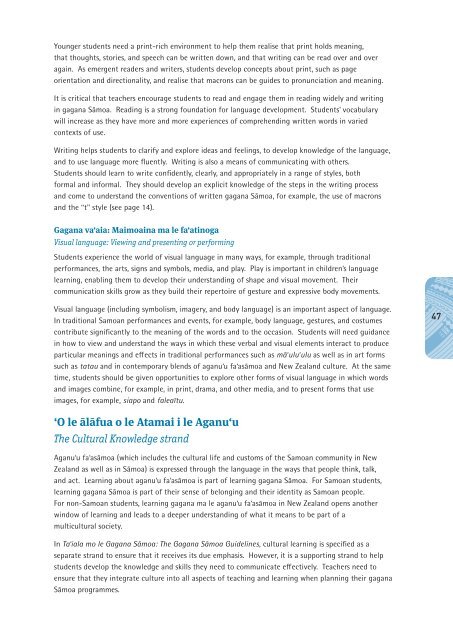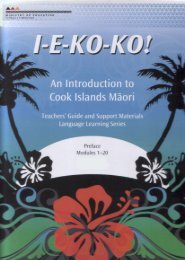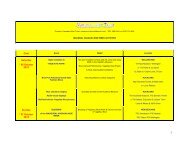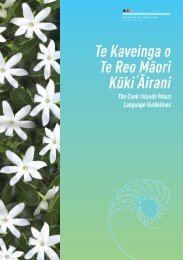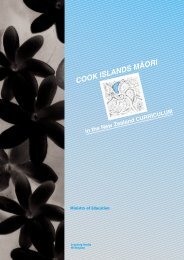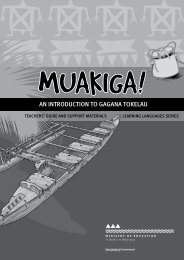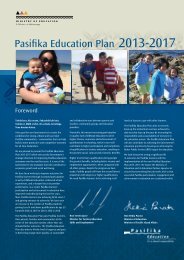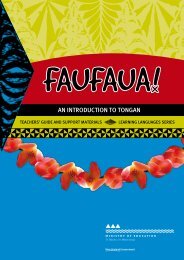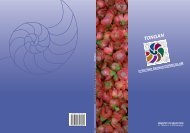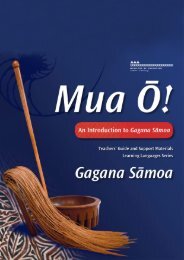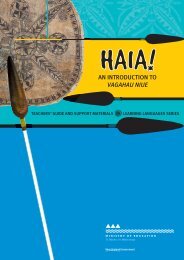Ta'iala mo le Gagana SÄmoa - Pasifika Education Community
Ta'iala mo le Gagana SÄmoa - Pasifika Education Community
Ta'iala mo le Gagana SÄmoa - Pasifika Education Community
You also want an ePaper? Increase the reach of your titles
YUMPU automatically turns print PDFs into web optimized ePapers that Google loves.
Younger students need a print-rich environment to help them realise that print holds meaning,that thoughts, stories, and speech can be written down, and that writing can be read over and overagain. As emergent readers and writers, students develop concepts about print, such as pageorientation and directionality, and realise that macrons can be guides to pronunciation and meaning.It is critical that teachers encourage students to read and engage them in reading widely and writingin gagana Sā<strong>mo</strong>a. Reading is a strong foundation for language development. Students’ vocabularywill increase as they have <strong>mo</strong>re and <strong>mo</strong>re experiences of comprehending written words in variedcontexts of use.Writing helps students to clarify and explore ideas and feelings, to develop know<strong>le</strong>dge of the language,and to use language <strong>mo</strong>re fluently. Writing is also a means of communicating with others.Students should <strong>le</strong>arn to write confidently, c<strong>le</strong>arly, and appropriately in a range of sty<strong>le</strong>s, bothformal and informal. They should develop an explicit know<strong>le</strong>dge of the steps in the writing processand come to understand the conventions of written gagana Sā<strong>mo</strong>a, for examp<strong>le</strong>, the use of macronsand the “t” sty<strong>le</strong> (see page 14).<strong>Gagana</strong> va‘aia: Mai<strong>mo</strong>aina ma <strong>le</strong> fa‘atinogaVisual language: Viewing and presenting or performingStudents experience the world of visual language in many ways, for examp<strong>le</strong>, through traditionalperformances, the arts, signs and symbols, media, and play. Play is important in children’s language<strong>le</strong>arning, enabling them to develop their understanding of shape and visual <strong>mo</strong>vement. Theircommunication skills grow as they build their repertoire of gesture and expressive body <strong>mo</strong>vements.Visual language (including symbolism, imagery, and body language) is an important aspect of language.In traditional Sa<strong>mo</strong>an performances and events, for examp<strong>le</strong>, body language, gestures, and costumescontribute significantly to the meaning of the words and to the occasion. Students will need guidancein how to view and understand the ways in which these verbal and visual e<strong>le</strong>ments interact to produceparticular meanings and effects in traditional performances such as mā‘ulu‘ulu as well as in art formssuch as tatau and in contemporary b<strong>le</strong>nds of aganu‘u fa‘asā<strong>mo</strong>a and New Zealand culture. At the sametime, students should be given opportunities to explore other forms of visual language in which wordsand images combine, for examp<strong>le</strong>, in print, drama, and other media, and to present forms that useimages, for examp<strong>le</strong>, siapo and fa<strong>le</strong>aītu.47‘O <strong>le</strong> ālāfua o <strong>le</strong> Atamai i <strong>le</strong> Aganu‘uThe Cultural Know<strong>le</strong>dge strandAganu‘u fa‘asā<strong>mo</strong>a (which includes the cultural life and customs of the Sa<strong>mo</strong>an community in NewZealand as well as in Sā<strong>mo</strong>a) is expressed through the language in the ways that peop<strong>le</strong> think, talk,and act. Learning about aganu‘u fa‘asā<strong>mo</strong>a is part of <strong>le</strong>arning gagana Sā<strong>mo</strong>a. For Sa<strong>mo</strong>an students,<strong>le</strong>arning gagana Sā<strong>mo</strong>a is part of their sense of belonging and their identity as Sa<strong>mo</strong>an peop<strong>le</strong>.For non-Sa<strong>mo</strong>an students, <strong>le</strong>arning gagana ma <strong>le</strong> aganu‘u fa‘asā<strong>mo</strong>a in New Zealand opens anotherwindow of <strong>le</strong>arning and <strong>le</strong>ads to a deeper understanding of what it means to be part of amulticultural society.In Ta‘iala <strong>mo</strong> <strong>le</strong> <strong>Gagana</strong> Sā<strong>mo</strong>a: The <strong>Gagana</strong> Sā<strong>mo</strong>a Guidelines, cultural <strong>le</strong>arning is specified as aseparate strand to ensure that it receives its due emphasis. However, it is a supporting strand to helpstudents develop the know<strong>le</strong>dge and skills they need to communicate effectively. Teachers need toensure that they integrate culture into all aspects of teaching and <strong>le</strong>arning when planning their gaganaSā<strong>mo</strong>a programmes.


